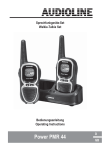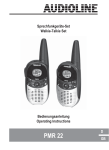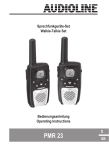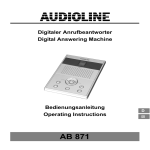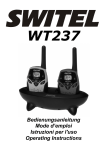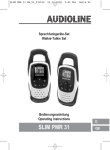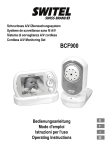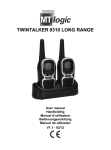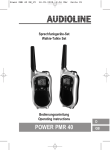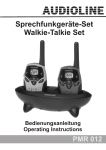Download AUDIOLINE PMR 22 Operating instructions
Transcript
PMR 46 DE_041212_dtp 04.12.12 12:31 Seite U1 Sprechfunkgeräte-Set Walkie-Talkie Set Bedienungsanleitung Operating Instructions PMR 46 D GB PMR 46 DE_041212_dtp 04.12.12 12:31 Seite U2 PMR 46 DE_041212_dtp 04.12.12 12:31 Seite 1 Inhaltsverzeichnis 1 Sicherheitshinweise . . . . . . . . . . . . . . . . . . . . . . . . . . . . . . . . . . . . .2 Bestimmungsgemäße Verwendung . . . . . . . . . . . . . . . . . . . . . . . . . . . . .2 Verwendungsbereich . . . . . . . . . . . . . . . . . . . . . . . . . . . . . . . . . . . . . . . .2 Netzteil . . . . . . . . . . . . . . . . . . . . . . . . . . . . . . . . . . . . . . . . . . . . . . . . . . .2 Akkus . . . . . . . . . . . . . . . . . . . . . . . . . . . . . . . . . . . . . . . . . . . . . . . . . . . .2 Medizinische Geräte . . . . . . . . . . . . . . . . . . . . . . . . . . . . . . . . . . . . . . . . .2 Entsorgung . . . . . . . . . . . . . . . . . . . . . . . . . . . . . . . . . . . . . . . . . . . . . . . .2 Konformitätserklärung . . . . . . . . . . . . . . . . . . . . . . . . . . . . . . . . . . . . . . . .3 2 Funkgeräte in Betrieb nehmen . . . . . . . . . . . . . . . . . . . . . . . . . . . .4 Sicherheitshinweise . . . . . . . . . . . . . . . . . . . . . . . . . . . . . . . . . . . . . . . . .4 Verpackungsinhalt prüfen . . . . . . . . . . . . . . . . . . . . . . . . . . . . . . . . . . . . .4 Gürtelclip . . . . . . . . . . . . . . . . . . . . . . . . . . . . . . . . . . . . . . . . . . . . . . . . .4 Akkus einlegen . . . . . . . . . . . . . . . . . . . . . . . . . . . . . . . . . . . . . . . . . . . . .4 Akkus aufladen . . . . . . . . . . . . . . . . . . . . . . . . . . . . . . . . . . . . . . . . . . . . .4 3 Bedienelemente . . . . . . . . . . . . . . . . . . . . . . . . . . . . . . . . . . . . . . . . .7 4 Funkgeräte bedienen . . . . . . . . . . . . . . . . . . . . . . . . . . . . . . . . . . . .8 Funkgeräte ein-/ausschalten . . . . . . . . . . . . . . . . . . . . . . . . . . . . . . . . . .8 Einstellen der Lautstärke . . . . . . . . . . . . . . . . . . . . . . . . . . . . . . . . . . . . .8 Senden und empfangen . . . . . . . . . . . . . . . . . . . . . . . . . . . . . . . . . . . . . .8 Rufton senden . . . . . . . . . . . . . . . . . . . . . . . . . . . . . . . . . . . . . . . . . . . . .8 Kanalwahl . . . . . . . . . . . . . . . . . . . . . . . . . . . . . . . . . . . . . . . . . . . . . . . . .9 CTCSS-Code wählen . . . . . . . . . . . . . . . . . . . . . . . . . . . . . . . . . . . . . . . .9 DCS-Code wählen . . . . . . . . . . . . . . . . . . . . . . . . . . . . . . . . . . . . . . . . .10 Kanalüberwachung (Monitoring) . . . . . . . . . . . . . . . . . . . . . . . . . . . . . . .11 VOX-Modus . . . . . . . . . . . . . . . . . . . . . . . . . . . . . . . . . . . . . . . . . . . . . . .11 Automatischer Kanal-Scan . . . . . . . . . . . . . . . . . . . . . . . . . . . . . . . . . . .12 Automatischer Subkanal (CTCSS)-Scan . . . . . . . . . . . . . . . . . . . . . . . .12 Automatischer DCS-Scan . . . . . . . . . . . . . . . . . . . . . . . . . . . . . . . . . . . .12 Rufton wählen . . . . . . . . . . . . . . . . . . . . . . . . . . . . . . . . . . . . . . . . . . . .13 Bestätigungston . . . . . . . . . . . . . . . . . . . . . . . . . . . . . . . . . . . . . . . . . . .13 Tastenton . . . . . . . . . . . . . . . . . . . . . . . . . . . . . . . . . . . . . . . . . . . . . . . .13 Zweikanal-Überwachung . . . . . . . . . . . . . . . . . . . . . . . . . . . . . . . . . . . .14 Tastensperre . . . . . . . . . . . . . . . . . . . . . . . . . . . . . . . . . . . . . . . . . . . . . .15 Stoppuhr . . . . . . . . . . . . . . . . . . . . . . . . . . . . . . . . . . . . . . . . . . . . . . . . .15 Headset . . . . . . . . . . . . . . . . . . . . . . . . . . . . . . . . . . . . . . . . . . . . . . . . . .15 5 Anhang . . . . . . . . . . . . . . . . . . . . . . . . . . . . . . . . . . . . . . . . . . . . . . .16 Falls es Probleme gibt . . . . . . . . . . . . . . . . . . . . . . . . . . . . . . . . . . . . . .16 Steckerbelegung für die Headset-Buchse . . . . . . . . . . . . . . . . . . . . . . .16 Technische Daten . . . . . . . . . . . . . . . . . . . . . . . . . . . . . . . . . . . . . . . . . .17 Pflegehinweise / Garantie . . . . . . . . . . . . . . . . . . . . . . . . . . . . . . . . . . . .17 D 1 PMR 46 DE_041212_dtp 04.12.12 12:31 Seite 2 Sicherheitshinweise 1 Sicherheitshinweise Lesen Sie diese Bedienungsanleitung sorgfältig durch. Bestimmungsgemäße Verwendung Diese Sprechfunkgeräte sind geeignet für die Kommunikation mit anderen Sprechfunkgeräten gleichen Standards. Jede andere Verwendung gilt als nicht bestimmungsgemäß. Eigenmächtige Veränderungen oder Umbauten sind nicht zulässig. Öffnen Sie die Geräte in keinem Fall selbst und führen Sie keine eigenen Reparaturversuche durch. Verwendungsbereich Vermeiden Sie Belastungen durch Rauch, Staub, Erschütterungen, Chemikalien, Feuchtigkeit, Hitze oder direkte Sonneneinstrahlung. Verwenden Sie die Funkgeräte nicht in explosionsgefährdeten Bereichen. Netzteil a Achtung: Verwenden Sie nur das mitgelieferte Netzteil, da andere Netzteile die Funkgeräte beschädigen können. Sie dürfen den Zugang zum Netzteil nicht durch Möbel oder andere Gegenstände versperren. Akkus a Achtung: Werfen Sie Akkus nicht ins Feuer. Verwenden Sie nur Akkus des gleichen Typs! Achten Sie auf die richtige Polung! Bei verkehrter Polung der Akkus besteht beim Aufladen Explosionsgefahr. Medizinische Geräte a Achtung: Benutzen Sie das Gerät nicht in der Nähe von medizinischen Geräten. Eine Beeinflussung kann nicht völlig ausgeschlossen werden. Funkgeräte können in Hörgeräten einen unangenehmen Brummton verursachen. Entsorgung Wollen Sie Ihr Gerät entsorgen, bringen Sie es zur Sammelstelle Ihres kommunalen Entsorgungsträgers (z. B. Wertstoffhof). Nach dem Elektro- und Elektronikgerätegesetz sind Besitzer von Altgeräten gesetzlich verpflichtet, alte Elektro2 PMR 46 DE_041212_dtp 04.12.12 12:31 Seite 3 Sicherheitshinweise und Elektronikgeräte einer getrennten Abfallerfassung zuzuführen. Das nebenstehende Symbol bedeutet, dass Sie das Gerät auf keinen Fall in den Hausmüll werfen dürfen! Gefährdung von Gesundheit und Umwelt durch Akkus und Batterien! Akkus und Batterien nie öffnen, beschädigen, verschlucken oder in die Umwelt gelangen lassen. Sie können giftige und umweltschädliche Schwermetalle enthalten. Sie sind gesetzlich verpflichtet, Akkus und Batterien beim batterievertreibenden Handel sowie bei zuständigen Sammelstellen, die entsprechende Behälter bereitstellen, sicher zu entsorgen. Die Entsorgung ist unentgeltlich. Die nebenstehenden Symbole bedeuten, dass Sie Akkus und Batterien auf keinen Fall in den Hausmüll werfen dürfen und sie über Sammelstellen der Entsorgung zugeführt werden müssen. Verpackungsmaterialien entsorgen Sie entsprechend den lokalen Vorschriften. a Achtung: Setzen Sie das Gerät niemals tropfenden oder spritzenden Flüssigkeiten aus und sorgen Sie dafür, dass keine flüssigkeitsgefüllten Gefäße wie z. B. Gläser auf dem Gerät stehen. Konformitätserklärung Dieses Gerät erfüllt die Anforderungen der EU-Richtlinien: - 1999/5/EG Richtlinie über Funkanlagen und Telekommunikationsendeinrichtungen und die gegenseitige Anerkennung ihrer Konformität. - 2005/32/EG Richtlinie „Energiebetriebene Produkte“. Die Konformität mit der o. a. Richtlinie wird durch das CE-Zeichen auf dem Gerät bestätigt. Für die komplette Konformitätserklärung nutzen Sie bitte den kostenlosen Download von unserer Website www.audioline.de. Dieses Produkt ist für den Betrieb innerhalb Deutschlands entwickelt worden. Es arbeitet auf einer EU-harmonisierten Frequenz (446 MHz) und darf daher außerhalb Deutschlands in allen EU-Mitgliedstaaten betrieben werden. D 3 PMR 46 DE_041212_dtp 04.12.12 12:31 Seite 4 Funkgeräte in Betrieb nehmen 2 Funkgeräte in Betrieb nehmen Sicherheitshinweise a Achtung: Lesen Sie vor der Inbetriebnahme unbedingt die Sicherheitshinweise in Kapitel 1. Verpackungsinhalt prüfen Zum Lieferumfang gehören: - 2 Funkgeräte mit Gürtelclip - 2 Headsets - 1 Bedienungsanleitung - 6 Akkus, AAA, 600 mAh NiMH - 1 Ladestation - 1 Netzteil Gürtelclip Zum Entfernen des Gürtelclips heben Sie die Sperre mit einem Fingernagel an (s. Skizze) und schieben ihn aus der Halterung. Zum Anbringen des Gürtelclips schieben Sie ihn in die Halterung bis er hörbar einrastet. Akkus einlegen Öffnen Sie das Akkufach. Legen Sie die mitgelieferten Akkus ein. Achten Sie auf die richtige Polung! Schließen Sie das Akkufach. a Achtung: Verwenden Sie nur die mitgelieferten Akkus oder Akkus der gleichen Bauweise und Kapazität. Wenn die Akkus falsch eingesetzt werden besteht Explosionsgefahr. Setzen Sie Akkus niemals übermäßiger Hitze wie direkter Sonneneinstrahlung, Feuer o. ä. aus. 4 PMR 46 DE_041212_dtp 04.12.12 12:31 Seite 5 Funkgeräte in Betrieb nehmen Akkus aufladen Schließen Sie die Ladestation an. Verwenden Sie aus Sicherheitsgründen nur das mitgelieferte Ladegerät. Laden Sie die Funkgeräte vor der ersten Inbetriebnahme für mindestens 10 Stunden. Wenn die Funkgeräte korrekt platziert sind, leuchten die Ladeanzeigen. Die roten LEDs leuchten auch, wenn die Akkupacks komplett aufgeladen sind. Für eine optimale Akkulebensdauer trennen Sie dann bitte die Funkgeräte von der Ladestation. Schalten Sie die Funkgeräte zum Laden aus, um die Ladezeit zu verkürzen. Neue Akkus benötigen ca. 14 Stunden Ladezeit. a Achtung: Laden Sie die Funkgeräte nicht mit fremden Aufladegeräten. Der aktuelle Akkuladezustand wird im Display angezeigt: voll halb schwach leer Sobald die Anzeige im Display blinkt und Warntöne zu hören sind, muss das Funkgerät aufgeladen werden. D 5 PMR 46 DE_041212_dtp 04.12.12 12:31 Seite 6 Funkgeräte in Betrieb nehmen Alternativ können Sie jedes einzelne Funkgerät direkt mit dem Netzgerät aufladen. Heben Sie die Abdeckung an der Oberseite des Gerätes ab und stecken Sie den Ladestecker in die passende Buchse. Schalten Sie die Funkgeräte zum Laden aus um die Ladezeit zu verkürzen. 6 Anschluss für Headset Anschluss für Ladegerät PMR 46 DE_041212_dtp 04.12.12 12:31 Seite 7 Bedienelemente 3 Bedienelemente Handset 1 Antenne 2 Anschluss für Ladegerät und Headset 3 Display 4 PTT-(Sprech)taste 5 Ein/Aus-Taste 6 Auf/Ab-Tasten für Kanalwahl, Lautstärke und weitere Einstellungen 7 Mikrofon 8 Lautsprecher 9 Rufton senden 10 Menü-Taste 1 2 3 10 4 5 9 6 7 Display 1 DCS aktiv (Advanced Digital Code) 2 CTCSS aktiv (Sub-Kanal) 3 Scan-Mode 4 Anzeige „Senden“ 1 5 Anzeige „Empfangen“ 2 6 Akkukapazitätsanzeige 3 7 Tastensperre 4 8 Rufsignal aktiviert 5 9 Lautstärkeanzeige 10 Kanalanzeige 11 2-Kanal-Überwachung 12 VOX-Mode 13 Sub-Kanalanzeige (CTCSS) oder Code-Anzeige (DCS) 8 13 12 11 10 6 7 8 9 D 7 PMR 46 DE_041212_dtp 04.12.12 12:31 Seite 8 Funkgeräte bedienen 4 Funkgeräte bedienen Funkgeräte ein-/ausschalten Zum Einschalten Ein/Aus-Taste drücken und gedrückt halten. Sie hören einen Signalton und im Display wird der derzeitige Kanal angezeigt. Zum Ausschalten Ein/Aus-Taste drücken und gedrückt halten. Sie hören einen Signalton. Einstellen der Lautstärke Drücken Sie ▲ oder ▼ um die Lautstärke zu erhöhen / oder zu verringern. Senden und empfangen Senden Drücken Sie die PTT-(Sprech)taste. TX wird angezeigt. ☞ Halten Sie das Funkgerät ca. 5 bis 7 cm vom Mund entfernt, warten Sie ca. 1 Sekunde und sprechen Sie mit normaler Lautstärke. Um mit anderen Teilnehmern zu sprechen, müssen alle Funkgeräte auf den gleichen Kanal eingestellt sein. Empfangen Das Funkgerät ist ständig in Empfangsbereitschaft, wenn es eingeschaltet ist und die PTT-(Sprech)taste bzw. die Ruftaste nicht gedrückt ist. RX wird angezeigt. ☞ Sie können keine Funksignale empfangen, wenn Sie die PTT-(Sprech)taste gedrückt halten. Rufton senden Der Rufton macht andere Teilnehmer darauf aufmerksam, dass Sie ein Gespräch beginnen möchten. Die anderen Teilnehmer müssen den gleichen Kanal und CTCSS-Code/DCS-Code verwenden. Rufton senden. 8 PMR 46 DE_041212_dtp 04.12.12 12:31 Seite 9 Funkgeräte bedienen Kanalwahl Drücken Sie die Menü-Taste. Drücken Sie ▲ oder ▼ um den gewünschten Kanal zu wählen. Bestätigen Sie die Einstellung mit der PTT(Sprech)taste. / Kanal 1 2 3 4 Frequenz (MHz) 446.00625 446.01875 446.03125 446.04375 Kanal 5 6 7 8 Frequenz (MHz) 446.05625 446.06875 446.08125 446.09375 CTCSS-Code wählen CTCSS = Continous Tone Coded Squelch System = Selektivruf. Es werden alle Gespräche an Funkgeräten signalisiert, die sich im Empfangsbereich befinden. Voraussetzung dafür ist, dass alle Funkgeräte auf den gleichen Kanal eingestellt sind. Um gegenseitige Störungen zu vermeiden, kann auf dem eingestellten Kanal ein CTCSS-Code festgelegt werden. Es sind 38 CTCSS-Codes pro Kanal möglich. Hinweis: CTCSS- und DCS-Codes können nur alternativ verwendet werden. 2x Drücken Sie die Menü-Taste 2 mal. / CTCSS-Code auswählen und mit der PTT-(Sprech)taste bestätigen. ☞ Jeder CTCSS-Code entspricht einer bestimmten Tonfrequenz, die das Sprechfunkgerät sendet. Die Kommunikation zwischen zwei Teilnehmern ist nur dann möglich, wenn beide denselben Kanal und CTCSS-Code verwenden. Eine Ausnahme ist der CTCSS-Code “00” (= OF / Aus). Bei dieser Einstellung können, unabhängig vom CTCSS-Code, alle Gespräche auf dem eingestellten Kanal gehört werden. Um am Funkverkehr teilnehmen zu können, muss dann ggf. vom CTCSS-Code “00" auf den verwendeten CTCSS-Code gewechselt werden. D 9 PMR 46 DE_041212_dtp 04.12.12 12:31 Seite 10 Funkgeräte bedienen Wenn Sie mit Funkgeräten kommunizieren möchten, die keinen CTCSSCode verwenden, müssen Sie an Ihrem Funkgerät den CTCSS-Code “00" auswählen. CTCSS 1 2 3 4 5 6 7 8 9 10 11 12 13 14 15 16 17 18 19 Frequenz (Hz) 67,0 71,9 74,4 77,0 79,7 82,5 85,4 88,5 91,5 94,8 97,4 100,0 103,5 107,2 110,9 114,8 118,8 123,0 127,3 CTCSS 20 21 22 23 24 25 26 27 28 29 30 31 32 33 34 35 36 37 38 Frequenz (Hz) 131,8 136,5 141,3 146,2 151,4 156,7 162,2 167,9 173,8 179,9 186,2 192,8 203,5 210,7 218,1 225,7 233,6 241,8 250,3 DCS-Code wählen DCS = Advanced Digital Code Jeder Kanal stellt Ihnen alternativ zum vorgenannten CTCSS-Code 83 DCS-Codes zur Verfügung, um Ihre Verbindungen noch sicherer zu machen. Bitte beachten Sie, dass an jedem der teilnehmenden Funkgeräte derselbe DCS-Code eingestellt sein muss. Die Einstellung „00“ / „OF“ bedeutet, dass der DCS-Code ausgeschaltet ist. Hinweis: DCS- und CTCSS-Codes können nur alternativ verwendet werden. 3x Drücken Sie die Menü-Taste 3 mal. / 10 DCS-Code auswählen und mit der PTT-(Sprech)taste bestätigen. PMR 46 DE_041212_dtp 04.12.12 12:31 Seite 11 Funkgeräte bedienen Kanalüberwachung (Monitoring) Im Normalfall unterdrückt das Funkgerät sehr schwache Empfangssignale. Mit der „Monitoring“-Funktion können Sie auf dem eingestellten Kanal jedoch alle Signale empfangen. + Drücken Sie gleichzeitig die Menü-Taste und die Taste ▼. Im Display erscheint RX. Zum Beenden drücken Sie die Menü-Taste erneut. VOX-Modus VOX = Voice operated transmission = Geräuschaktivierte Übertragung. Bei eingeschaltetem VOX-Modus sendet Ihr Gerät sobald es ein Geräusch wahrnimmt. Beim Einschalten des VOX-Modus stellen Sie gleichzeitig die Empfindlichkeit ein. Je höher die angezeigte Ziffer desto empfindlicher ist die Einstellung. ☞ Wenn Sie anfangen zu sprechen, tritt eine kurze Verzögerung auf, bevor das Funkgerät sendet. Wenn für ca. 2 Sekunden kein Geräusch wahrgenommen wird, wird die Übertragung beendet. In einer lauten oder windigen Umgebung ist die Verwendung des VOXModus nicht empfehlenswert. 4x Drücken Sie die Menü-Taste 4 mal. VOX wird angezeigt und „OF“ blinkt im Display. / Wählen Sie die gewünschte Empfindlichkeit (drei Stufen) mit den Auf/Ab-Tasten und bestätigen Sie die Einstellung mit der PTT-(Sprech)taste. Wenn der VOX-Modus aktiviert ist, wird VOX im Display angezeigt. Zum Ausschalten wählen Sie statt einer Empfindlichkeitsstufe „OF“ und bestätigen mit der PTT-(Sprech)taste. D 11 PMR 46 DE_041212_dtp 04.12.12 12:31 Seite 12 Funkgeräte bedienen Automatischer Kanal-Scan Ist diese Funktion eingeschaltet, werden alle Kanäle kontinuierlich solange nacheinander abgesucht, bis auf einem Kanal ein Signal empfangen wird. 5x Drücken Sie die Menü-Taste 5 mal. / Drücken Sie ▲ oder ▼ um den Kanal-Scan zu starten. Wird ein Signal empfangen, hält das Gerät an. / Drücken Sie ▲ oder ▼ um mit dem Scannen der 8 Kanäle fortzufahren. Drücken Sie die PTT-(Sprech)taste um sich in den Funkverkehr einzuschalten oder den Scan zu stoppen. Automatischer Subkanal (CTCSS)-Scan Ist diese Funktion eingeschaltet, werden für den eingestellten Kanal kontinuierlich alle Subkanäle (CTCSS) solange nacheinander abgesucht, bis ein Signal empfangen wird. 6x Drücken Sie die Menü-Taste 6 mal. / Drücken Sie ▲ oder ▼ um den Subkanal-Scan zu starten. Wird ein Signal empfangen, hält das Gerät an. / Drücken Sie ▲ oder ▼ um mit dem Scannen fortzufahren. Drücken Sie die PTT-(Sprech)taste um sich in den Funkverkehr einzuschalten oder den Scan zu stoppen. Automatischer DCS-Scan Ist diese Funktion eingeschaltet, werden für den eingestellten Kanal kontinuierlich alle DCS-Kanäle solange nacheinander abgesucht, bis ein Signal empfangen wird. 7x Drücken Sie die Menü-Taste 7 mal. / 12 Drücken Sie ▲ oder ▼ um den DCS-Kanal-Scan zu starten. PMR 46 DE_041212_dtp 04.12.12 12:31 Seite 13 Funkgeräte bedienen Wird ein Signal empfangen, hält das Gerät an. / Drücken Sie ▲ oder ▼ um mit dem Scannen fortzufahren. Drücken Sie die PTT-(Sprech)taste um sich in den Funkverkehr einzuschalten oder den Scan zu stoppen. Rufton wählen Sie haben 15 Ruftöne zur Auswahl. 8x Drücken Sie die Menü-Taste 8 mal. / Wählen Sie den gewünschten Rufton. Bestätigen Sie mit der PTT-(Sprech)taste. Bestätigungston Der Bestätigungston ist zu hören, wenn Sie die PTT-(Sprech)taste loslassen. Dadurch wird Ihrem Gesprächspartner signalisiert, dass Ihre Übertragung beendet ist. 9x Drücken Sie die Menü-Taste 9 mal. / Wählen Sie „ON“ oder „OF“ und bestätigen Sie mit der PTT-(Sprech)taste. Tastenton Bei aktiviertem Tastenton ist bei jeder Tastenbetätigung ein kurzer Ton zu hören. 10 x Drücken Sie die Menü-Taste 10 mal. / Wählen Sie „ON“ oder „OF“ und bestätigen Sie mit der PTT-(Sprech)taste. D 13 PMR 46 DE_041212_dtp 04.12.12 12:31 Seite 14 Funkgeräte bedienen Zweikanal-Überwachung Bei aktivierter Zweikanal-Überwachung werden abwechselnd zwei von Ihnen festzulegende Kanäle überwacht. Wird auf einem dieser Kanäle ein Signal empfangen, bleibt das Gerät auf diesem stehen. Sie können sich dann in den Funkverkehr auf diesem Kanal einschalten. / 11 x Stellen Sie den ersten der zu überwachenden Kanäle ein. Drücken Sie die Menü-Taste 11 mal. DCM erscheint im Display und „OF“ blinkt. / Wählen Sie den zweiten Kanal. Starten Sie die Zweikanal-Überwachung mit der PTT(Sprech)taste oder Drücken Sie die Menü-Taste. / Wählen Sie den CTCSS-Code für den zweiten Kanal. Starten Sie die Zweikanal-Überwachung mit der PTT(Sprech)taste oder Drücken Sie die Menü-Taste. / Wählen Sie den DCS-Code für den zweiten Kanal. Starten Sie die Zweikanal-Überwachung mit der PTT(Sprech)taste. Zum Ausschalten der Zweikanal-Überwachung drücken Sie die Menü-Taste 11 mal, wählen Sie „OF“ und drücken Sie die PTT-(Sprech)taste. 14 PMR 46 DE_041212_dtp 04.12.12 12:31 Seite 15 Funkgeräte bedienen Tastensperre Die Tastensperre verhindert das ungewollte Ändern von Einstellungen. Im Display erscheint das Symbol . Sie können weiterhin senden, empfangen, den eingestellten Kanal rufen oder das Gerät ausschalten. Tastensperre einschalten Drücken und halten Sie die Menütaste, bis das Symbol im Display erscheint. Tastensperre ausschalten Drücken und halten Sie die Menütaste, bis das Symbol wieder verschwindet. Stoppuhr Hinweis: Bei aktiver Zweikanal-Überwachung kann die Stoppuhr nicht genutzt werden. Drücken und halten Sie die Ruftaste für ca. 3 Sekunden. Drücken Sie ▲ um die Stoppuhr zu starten. Um die Stoppuhr anzuhalten drücken Sie ▲ erneut. Um die Stoppuhr zurückzusetzen drücken Sie ▼. Zum Beenden der Funktion drücken und halten Sie die Ruftaste für ca. 3 Sekunden. Headset Benutzen Sie das in der Verpackung enthaltene Headset. Stecken Sie das Funkgerät beispielsweise in die Brusttasche, um beide Hände frei zu haben. Da das mitgelieferte Headset über eine zusätzliche PTT-(Sprech)taste verfügt, können Sie über diese am Headset senden. Vorsicht beim Betrieb mit Headset: Zu hohe Lautstärke kann zu bleibenden Gehörschäden führen. Kontrollieren Sie deshalb vorher die Lautstärkeeinstellung. D 15 PMR 46 DE_041212_dtp 04.12.12 12:31 Seite 16 Anhang 5 Anhang Falls es Probleme gibt Haben Sie Probleme mit Ihren Funkgeräten, kontrollieren Sie zuerst die folgenden Hinweise. Bei Garantieansprüchen wenden Sie sich an Ihren Fachhändler. Die Garantiezeit beträgt 2 Jahre. Fragen und Antworten Fragen Keine Funktion Senden nicht möglich Kein Empfang Antworten - Funkgerät nicht geladen - Tastensperre aktiviert - PTT-(Sprech)taste zum Senden vollständig drücken - Kanal wird von anderen Teilnehmern benutzt - PTT-(Sprech)taste loslassen - Lautstärke zu gering eingestellt - Sie befinden sich außerhalb des Empfangsbereichs, ändern Sie Ihre Position - Hindernisse wie Bäume und Gebäude haben einen negativen Einfluss auf die Reichweite - CTCSS-Code/DCS-Code ist nicht identisch mit dem des Gesprächspartners - Kanal wird von anderen Teilnehmern benutzt Steckerbelegung für die Headset-Buchse Wollen Sie statt des mitgelieferten Headsets ein anderes Headset anschließen achten Sie bitte auf eine korrekte Steckerbelegung (s. Skizze). 3-poliger 2,5 mm Stereoklinkenstecker 1 = Mikrofon 2 = Lautsprecher 3 = Masse 16 PMR 46 DE_041212_dtp 04.12.12 12:31 Seite 17 Anhang Technische Daten Merkmal Ausgangsleistung Reichweite Gesamt-Betriebszeit Max. Gesprächsdauer Ladezeit Akkus Stromversorgung Wert 0,5 W bis zu 8 km bei freier Sichtlinie Bis zu 14 Std. (Basierend auf 5 % Senden, 5 % Empfangen und 90 % Stand-by-Zeit) Bis zu 100 Min. ca. 10 Std. 3 x NiMH 1,2 V, 600 mAh Eingang: 230 / 240 V, 50 Hz, 36 mA Ausgang: 9 V, 300 mA DC Pflegehinweise / Garantie Pflegehinweise Reinigen Sie die Gehäuseoberflächen mit einem weichen und fusselfreien Tuch. Verwenden Sie keine Reinigungsmittel oder Lösungsmittel. Garantie AUDIOLINE-Geräte werden nach den modernsten Produktionsverfahren hergestellt und geprüft. Ausgesuchte Materialien und hoch entwickelte Technologien sorgen für einwandfreie Funktion und lange Lebensdauer. Die Garantie gilt nicht für die in den Produkten verwendeten Batterien, Akkus oder Akkupacks. Die Garantiezeit beträgt 24 Monate, gerechnet vom Tage des Kaufs. Innerhalb der Garantiezeit werden alle Mängel, die auf Material- oder Herstellungsfehler zurückzuführen sind, kostenlos beseitigt. Der Garantieanspruch erlischt bei Eingriffen durch den Käufer oder durch Dritte. Schäden, die durch unsachgemäße Behandlung oder Bedienung, natürliche Abnutzung, durch falsches Aufstellen oder Aufbewahren, durch unsachgemäßen Anschluss oder Installation sowie durch höhere Gewalt oder sonstige äußere Einflüsse entstehen, fallen nicht unter die Garantieleistung. Wir behalten uns vor, bei Reklamationen die defekten Teile auszubessern, zu ersetzen oder das Gerät auszutauschen. Ausgetauschte Teile oder aus- D 17 PMR 46 DE_041212_dtp 04.12.12 12:31 Seite 18 Anhang getauschte Geräte gehen in unser Eigentum über. Schadenersatzansprüche sind ausgeschlossen, soweit sie nicht auf Vorsatz oder grober Fahrlässigkeit des Herstellers beruhen. Sollte Ihr Gerät dennoch einen Defekt innerhalb der Garantiezeit aufweisen, wenden Sie sich bitte unter Vorlage Ihrer Kaufquittung ausschließlich an das Geschäft, in dem Sie Ihr AUDIOLINE-Gerät gekauft haben. Alle Gewährleistungsansprüche nach diesen Bestimmungen sind ausschließlich gegenüber Ihrem Fachhändler geltend zu machen. Nach Ablauf von zwei Jahren nach Kauf und Übergabe unserer Produkte können Gewährleistungsrechte nicht mehr geltend gemacht werden. 18 PMR 46 GB_041212_dtp 04.12.12 12:33 Seite 1 Contents 1 Safety Information . . . . . . . . . . . . . . . . . . . . . . . . . . . . . . . . . . . . . . .2 Intended use . . . . . . . . . . . . . . . . . . . . . . . . . . . . . . . . . . . . . . . . . . . . . . .2 Ambient conditions . . . . . . . . . . . . . . . . . . . . . . . . . . . . . . . . . . . . . . . . . .2 Power supply . . . . . . . . . . . . . . . . . . . . . . . . . . . . . . . . . . . . . . . . . . . . . .2 Rechargeable batteries . . . . . . . . . . . . . . . . . . . . . . . . . . . . . . . . . . . . . . .2 Medical equipment . . . . . . . . . . . . . . . . . . . . . . . . . . . . . . . . . . . . . . . . . .2 Disposal . . . . . . . . . . . . . . . . . . . . . . . . . . . . . . . . . . . . . . . . . . . . . . . . . .2 Declaration of Conformity . . . . . . . . . . . . . . . . . . . . . . . . . . . . . . . . . . . . .3 2 Preparing the Walkie-Talkies for Use . . . . . . . . . . . . . . . . . . . . . . .4 Safety information . . . . . . . . . . . . . . . . . . . . . . . . . . . . . . . . . . . . . . . . . . .4 Checking the package contents . . . . . . . . . . . . . . . . . . . . . . . . . . . . . . . .4 Belt clip . . . . . . . . . . . . . . . . . . . . . . . . . . . . . . . . . . . . . . . . . . . . . . . . . . .4 Inserting the batteries . . . . . . . . . . . . . . . . . . . . . . . . . . . . . . . . . . . . . . . .4 Charging the batteries . . . . . . . . . . . . . . . . . . . . . . . . . . . . . . . . . . . . . . .5 3 Operating Elements . . . . . . . . . . . . . . . . . . . . . . . . . . . . . . . . . . . . .7 4 Operating the Walkie-Talkies . . . . . . . . . . . . . . . . . . . . . . . . . . . . . .8 Switching the walkie-talkie on/off . . . . . . . . . . . . . . . . . . . . . . . . . . . . . . .8 Volume control . . . . . . . . . . . . . . . . . . . . . . . . . . . . . . . . . . . . . . . . . . . . .8 Transmitting and receiving . . . . . . . . . . . . . . . . . . . . . . . . . . . . . . . . . . . .8 Transmit ringing tone . . . . . . . . . . . . . . . . . . . . . . . . . . . . . . . . . . . . . . . .8 Selecting a channel . . . . . . . . . . . . . . . . . . . . . . . . . . . . . . . . . . . . . . . . .9 Selecting the CTCSS code . . . . . . . . . . . . . . . . . . . . . . . . . . . . . . . . . . . .9 Selecting the DCS code . . . . . . . . . . . . . . . . . . . . . . . . . . . . . . . . . . . . .10 Monitoring the current channel . . . . . . . . . . . . . . . . . . . . . . . . . . . . . . . .11 VOX mode . . . . . . . . . . . . . . . . . . . . . . . . . . . . . . . . . . . . . . . . . . . . . . .11 Scanning channels . . . . . . . . . . . . . . . . . . . . . . . . . . . . . . . . . . . . . . . . .12 Scanning subchannels (CTCSS) . . . . . . . . . . . . . . . . . . . . . . . . . . . . . .12 Scanning DCS . . . . . . . . . . . . . . . . . . . . . . . . . . . . . . . . . . . . . . . . . . . .12 Selecting the ringing tone . . . . . . . . . . . . . . . . . . . . . . . . . . . . . . . . . . . .13 Roger Beep . . . . . . . . . . . . . . . . . . . . . . . . . . . . . . . . . . . . . . . . . . . . . . .13 Key Tone . . . . . . . . . . . . . . . . . . . . . . . . . . . . . . . . . . . . . . . . . . . . . . . . .13 Dual Watch Mode . . . . . . . . . . . . . . . . . . . . . . . . . . . . . . . . . . . . . . . . . .14 Key Lock . . . . . . . . . . . . . . . . . . . . . . . . . . . . . . . . . . . . . . . . . . . . . . . . .15 Stop Watch . . . . . . . . . . . . . . . . . . . . . . . . . . . . . . . . . . . . . . . . . . . . . . .15 Headset . . . . . . . . . . . . . . . . . . . . . . . . . . . . . . . . . . . . . . . . . . . . . . . . . .15 5 Appendix . . . . . . . . . . . . . . . . . . . . . . . . . . . . . . . . . . . . . . . . . . . . .16 In Case of Problems . . . . . . . . . . . . . . . . . . . . . . . . . . . . . . . . . . . . . . . .16 Pin assignment for the headset jack . . . . . . . . . . . . . . . . . . . . . . . . . . .16 Technical Properties . . . . . . . . . . . . . . . . . . . . . . . . . . . . . . . . . . . . . . . .17 Maintenance / Guarantee . . . . . . . . . . . . . . . . . . . . . . . . . . . . . . . . . . . .17 GB 1 PMR 46 GB_041212_dtp 04.12.12 12:33 Seite 2 Safety Information 1 Safety Information Please read this operating instruction manual thoroughly. Intended use These walkie-talkies have been conceived for communication with other walkie-talkies complying to the same standards. Any other use is considered unintended use. Unauthorised modification or reconstruction is not permitted. Under no circumstances open the devices or complete any repair work yourself. Ambient conditions Prevent excessive exposure to smoke, dust, vibration, chemicals, moisture, heat and direct sunlight. Do not use the walkie-talkies in potentially explosive areas. Power supply a Caution: Only use the power adapter plug supplied because other power supplies could damage the walkie-talkie equipment. Ensure access to the power adapter plug is not obstructed by furniture or such. Rechargeable batteries a Caution: Never throw batteries into a fire. Only use batteries of the same type! Pay attention to correct polarity. Incorrect polarity of the batteries represents a risk of explosion during charging. Medical equipment a Caution: Never use the walkie-talkies in the vicinity of medical equipment. Effects on such equipment cannot be fully ruled out. Walkietalkies can cause an unpleasant humming sound in hearing aids. Disposal In order to dispose of your device, take it to a collection point provided by your local public waste authorities (e.g. recycling centre). According to laws on the disposal of electronic and electrical devices, owners are obliged to dispose of old elec- 2 PMR 46 GB_041212_dtp 04.12.12 12:33 Seite 3 Safety Information tronic and electrical devices in a separate waste container. The adjacent symbol indicates that the device must not be disposed of in normal domestic waste! Batteries represent a hazard to both health and the environment! Never open, damage or swallow batteries, nor allow them to get into the environment. They may contain toxic and ecologically hazardous heavy metals. You are legally obliged to dispose of batteries at the point of sale or at appropriate collection points provided by your local public waste authorities. Disposal is free of charge. The adjacent symbols indicate that batteries must not be disposed of in normal domestic waste and but at authorised collection points. Packaging materials must be disposed of according to local regulations. a Caution: The apparatus shall not be exposed to dripping or splashing and that no objects filled with liquids, such as vases, shall be placed on the apparatus. Declaration of Conformity This device fulfils the requirements stipulated in the EU directives: - 1999/5/EU directive on radio equipment and telecommunications terminal equipment and the mutual recognition of their conformity. - 2005/32/EU directive “Energy-using products“. Conformity with the above mentioned directive is confirmed by the CE symbol on the device. Please refer to the free download in our Website www.audioline.de for complete declaration of conformity. This product has been developed for use within Germany. It operates on an EU-harmonised frequency band (446 MHz) and, thus, may be used outside Germany in all other EU member states. GB 3 PMR 46 GB_041212_dtp 04.12.12 12:33 Seite 4 Preparing the Walkie-Talkies for Use 2 Preparing the Walkie-Talkies for Use Safety information a Caution: It is essential to read the Safety Information in Chapter 1 before starting up. Checking the package contents The package contains: - 2 walkie-talkies with belt clip - 6 rechargeable batteries AAA / 600 mAh NiMH - 1 operating manual - a power adapter with charging plug Belt clip For removing the belt clip insert your finger nail and pull up the belt clip latch away from the unit. While pulling the belt clip latch push up the belt clip as shown. For attaching the belt clip slide it into the slot until a “click“ indicates that it is locked into it’s position. Inserting the batteries Open the battery compartment cover. Insert the batteries supplied. Pay attention to correct polarity. Close the battery compartment cover. a Caution: Only use the batteries supplied or ones of the same type. Danger of explosion if battery is incorrectly replaced. Batteries shall not be exposed to excessive heat such as sunshine,fire or the like. 4 PMR 46 GB_041212_dtp 04.12.12 12:33 Seite 5 Preparing the Walkie-Talkies for Use Charging the batteries Connect the charging station to the mains. For safety reasons, only use the power adapter plug supplied. Before using the walkie-talkies for the first time, charge them for at least 14 hours. When the walkie-talkies are connected correctly, the red LEDs light up. The LEDs only signal that the connection is correct and continue to light up even when the battery packs are fully charged. Disconnect the units after that time to extend the batteries’ life. Always turn off the PMR units when charging. This will shorten the charging time.New batteries take up to 14 hours to fully charge. a Caution: Do not charge the walkie-talkies with charging units from other manufacturers. The current battery charge status is indicated in the display: Full Half empty Low Empty As soon as the indicator flashes in the display and acoustic warning signals are issued, the batteries needs to be recharged. GB 5 PMR 46 GB_041212_dtp 04.12.12 12:33 Seite 6 Preparing the Walkie-Talkies for Use Alternatively you can charge each PMR by connecting the charger directly. Lift the charge socket cover located on the upper side of the handset and Insert the round connector of the 9.0V DC/300mA adaptor into the charge jack. Always turn off the PMR units when charging. This will shorten the charging time. 6 Headset jack Charger jack PMR 46 GB_041212_dtp 04.12.12 12:33 Seite 7 Operating elements 3 Operating Elements Handset 1 Antenna 2 Connection socket for headset/ charger 3 Display 4 PTT button 5 On/Off key 6 Up/Down Keys for changing channels, volume and other settings 7 Microphone 8 Loudspeaker 9 Transmit ring tone 10 Menu key Display 1 DCS activated (Advanced Digital Code) 2 CTCSS activated (sub channel) 3 Scan mode 4 Send 5 Receive 6 Battery charge capacity 7 Key lock 8 Call signal activated 9 Volume 10 Channel 11 Dual watch function activated 12 VOX mode 13 Subchannel (CTCSS) or Code (DCS) 1 2 3 10 4 5 9 6 7 8 1 2 13 3 12 11 10 4 5 6 7 8 9 GB 7 PMR 46 GB_041212_dtp 04.12.12 12:33 Seite 8 Operating the Walkie-Talkies 4 Operating the Walkie-Talkies Switching the walkie-talkie on/off For switching on the walkie-talkie press and hold down the menu key. A special “beep" sound will be heard and the LCD screen will display the current channel. For switching off the walkie-talkie press and hold down the menu key. A special “beep" sound will be heard and the LCD screen will turn blank. Volume control / Press ▲ or ▼ to increase or decrease the volume. Transmitting and receiving Transmitting Press the PTT button. TX will be displayed on the LCD screen. ☞ Hold the walkie-talkie approx. 5 to 7 cm from your mouth, wait for approx. 1 second and speak at a normal volume. In order to talk to other subscribers, the respective walkie-talkies must be set to the same channel. Receiving The unit is continuously in receive mode when the unit is turned ON and not transmitting. When a signal is received on the current channel, the receive signal icon RX will be displayed on the LCD screen. ☞ Radio signals cannot be received when the PTT button is being pressed. Transmit ringing tone The ringing tone indicates to other subscribers that you want to talk to them. A condition for this is that the other subscribers are using the same channel. Send ringing tone. 8 PMR 46 GB_041212_dtp 04.12.12 12:33 Seite 9 Operating the Walkie-Talkies Selecting a channel Press the menu key. / Press ▲ or ▼ to select the desired channel. Press the PTT button to confirm. Channel Frequency (MHz) 1 446.00625 2 446.01875 3 446.03125 4 446.04375 Channel Frequency (MHz) 5 446.05625 6 446.06875 7 446.08125 8 446.09375 Selecting the CTCSS code CTCSS: Continous Tone Coded Squelch System All the calls on walkie-talkies which occur within the range of reception are signalled. A condition for this is that all the walkie-talkies are set to the same channel. To prevent mutual interference, a CTCSS code can be defined for the set channel. 38 CTCSS codes can be set per channel. Note: CTCSS- and DCS-codes can only be used alternatively. 2x Press the menu key twice. / Select the CTCSS code and confirm with the PTT button. ☞ Each CTCSS code complies to a specific tone frequency transmitted by the walkie-talkie. Communication between the subscribers is only then possible when both parties are using the same channel and CTCSS code. An exception is CTCSS code “00” (= OF / off). In the case of this setting, all the calls on the set channel can be heard regardless of the CTCSS code. To be able to participate in the radio communication, it may be necessary to switch from CTCSS code “00” to the CTCSS code being used. If you want to communicate with the walkie-talkies which are not using a CTCSS, you must select CTCSS code “00” on your walkie-talkie. GB 9 PMR 46 GB_041212_dtp 04.12.12 12:33 Seite 10 Operating the Walkie-Talkies CTCSS 1 2 3 4 5 6 7 8 9 10 11 12 13 14 15 16 17 18 19 frequency (Hz) 67,0 71,9 74,4 77,0 79,7 82,5 85,4 88,5 91,5 94,8 97,4 100,0 103,5 107,2 110,9 114,8 118,8 123,0 127,3 CTCSS 20 21 22 23 24 25 26 27 28 29 30 31 32 33 34 35 36 37 38 frequency (Hz) 131,8 136,5 141,3 146,2 151,4 156,7 162,2 167,9 173,8 179,9 186,2 192,8 203,5 210,7 218,1 225,7 233,6 241,8 250,3 Selecting the DCS code DCS = Advanced Digital Code Alternatively to the above mentioned CTCSS code the unit offers 83 DCS codes to let you set up group of users for more secured private communication. Please note that every subscriber has to set the same DCS code. Note: DCS- and CTCSS-codes can only be used alternatively. 3x Press the menu key 3 times. / 10 Select the DCS code and confirm with the PTT button. PMR 46 GB_041212_dtp 04.12.12 12:33 Seite 11 Operating the Walkie-Talkies Monitoring the current channel Normally the walkie-talkie will not pick up very weak signals. But you can monitor the current channel for all sounds. + Press the menu key and the key ▼simultaneously. RX appears on the display. Press the menu key again to stop monitoring. VOX mode VOX = Voice operated transmission. In VOX mode your handset will transmit whenever it detects your voice (or other noise) without the PTT button having to be pressed. When turning on the VOX mode you will set the sensitivity. At the highest level (3), the handset will pickup softer noise (including background noise); at the lowest level, it will pick up only quite loud noise. ☞ When you start to speak, there is a slight delay before the walkie-talkie starts to transmit. If no noise is detected for approx. 2 seconds the transmission will be cut off. VOX operation is not recommended if the PMR will be used in a noisy or windy environment. 4x Press the menu key 4 times. VOX is displayed and „OF“ flashes on the display. / Select the sensitivity (3 Levels) using the up/down keys and confirm by pressing the PTT button. As long as the handset is in VOX mode, VOX will display steadily on the display. For deactivating the VOX mode select “OF“ instead of a sensitivity and confirm by pressing the PTT button. GB 11 PMR 46 GB_041212_dtp 04.12.12 12:33 Seite 12 Operating the Walkie-Talkies Scanning channels When the Scan function is turned on, the handset will continuously scan through all eight channels until it finds one on which another user is transmitting. 5x Press the menu key 5 times. / Press ▲ or ▼ to start scanning. When a signal is detected the unit will pause. / Press ▲ or ▼ to continue scanning. Press the PTT button to communicate or to quit scanning mode. Scanning subchannels (CTCSS) With this function activated the handset will continuously scan through all subchannels (CTCSS) for the preset channel until it finds one on which another user is transmitting. 6x Press the menu key 6 times. / Press ▲ or ▼ to start scanning. When a signal is detected the unit will pause. / Press ▲ or ▼ to continue scanning. Press the PTT button to communicate or to quit scanning mode. Scanning DCS With this function activated the handset will continuously scan through all DCS channels for the preset channel until it finds one on which another user is transmitting. 7x Press the menu key 7 times. / Press ▲ or ▼ to start scanning. When a signal is detected the unit will pause. 12 PMR 46 GB_041212_dtp 04.12.12 12:33 Seite 13 Operating the Walkie-Talkies / Press ▲ or ▼ to continue scanning. Press the PTT button to communicate or to quit scanning mode. Selecting the ringing tone There are 10 ringing tones available for selection. 8x Press the menu key 8 times. / Select the ringing tone. Confirm with the PTT button. Roger Beep The Roger Beep is a tone which is automatically transmitted whenever the PTT button is released. This alerts the receiving party to inform that you have intentionally ended the transmission, and you are now in receive mode. 9x Press the menu key 9 times. / Select “ON“ or “OF“ and confirm by pressing the PTT button. Key Tone This feature allows the PMR to emit a confirmation tone after pressing each button. 10 x Press the menu key 10 times. / Select “ON“ or “OF“ and confirm by pressing the PTT button. GB 13 PMR 46 GB_041212_dtp 04.12.12 12:33 Seite 14 Operating the Walkie-Talkies Dual Watch Mode With the dual watch mode activated two channels of your choice are watched alternately. If a signal on one of these channels is detected the dual watch mode is interrupted and you can take part in the communication on this channel. / 11 x Select the first channel (current channel). Press the menu key 11 times. DCM appears on the display and „OF“ is flashing. / Select the second channel. Press the PTT button to start the dual watch mode or Press the menu key. / Select the CTCSS code for the second channel. Press the PTT button to start the dual watch mode or Press the menu key. / Select the DCS code for the second channel. Press the PTT button to start the dual watch mode. For deactivating the Dual Watch Mode press the menu key 11 times, select “OF“ and press the PTT button. 14 PMR 46 GB_041212_dtp 04.12.12 12:33 Seite 15 Operating the Walkie-Talkies Key Lock The Key Lock feature allows user to disable the keys ▲, ▼ and the menu key so that the PMR settings could not be changed accidentally. appears on the display. All other functions such as sending, receiving or swiching off the unit can be used. To activate key lock Press and hold the menu key until the respective icon appears on the display. To deactivate key lock Press and hold the menu key until the respective icon disappears. Stop Watch Note: When Dual Watch Mode is activated this feature is not accessible. Press and hold the call key for approx. 3 seconds. Press ▲ to start the stop watch. Press ▲ again to stop. For resetting the stop watch press ▼. Press and hold down the call key for approx. 3 seconds to exit the function. Headset You can use the headset enclosed with the equipment to be able to work faster, for example. Clip the walkie-talkie on the belt so that you have both hands free. Since the headset supplied is equipped with an additional PTT button, you can transmit simply by using the PTT button on the headset. CAUTION: Excessive sound pressure from earphones and headphones can cause hearing loss. GB 15 PMR 46 GB_041212_dtp 04.12.12 12:33 Seite 16 Appendix 5 Appendix In Case of Problems Should problems arise with the walkie-talkies, please refer to the following information first. In the case of claims under the terms of guarantee, contact your sales outlet. There is a 2 year period of guarantee. Problems and solutions Problems Equipment does not function Transmission not possible No reception Solutions - Batteries have not been charged - Key lock has been activated - Press PTT button in fully to transmit - Channel is being used by other subscribers - Release PTT button - Volume setting is too low - You are outside the range of reception, change your position - Obstructions such as trees and buildings impair the range - CTCSS / DCS code set is not identical to that of the other party - Channel is being used by other subscribers Pin assignment for the headset jack If you want to connect a headset instead of the one supplied please take care for the correct pin assignment (refer to the diagram). 3-pin, 2.5 mm stereo jack plug 1 = Microphone 2 = Loudspeaker 3 = Earth 16 PMR 46 GB_041212_dtp 04.12.12 12:33 Seite 17 Appendix Technical Properties Feature Output power Range Using time Max. talk time Charging time Batteries Power supply Value 0.5 W Up to 8 km in open space Up to 14 h (based on 5 % “send“, 5 % “receive“ and 90 % stand-by-time) Up to 100 min approx. 10 h 3 x NiMH 1.2 V, 600 mAh Input: 230 / 240 V, 50 Hz, 36 mA Output: 9 V, 300 mA DC Maintenance / Guarantee Maintenance Clean the housing surfaces with a soft, fluff-free cloth. Never use cleaning agents or solvents. Guarantee AUDIOLINE equipment is produced and tested according to the latest production methods. The implementation of carefully chosen materials and highly developed technologies ensure trouble-free functioning and a long service life. The terms of guarantee do not apply to the batteries or power packs used in the products. The period of guarantee is 24 months from the date of purchase. All deficiencies resulting from material or production faults which occur during the period of guarantee will be eliminated free of charge. Rights to claims under the terms of guarantee are annulled following intervention by the purchaser or third parties. Damage caused as a result of improper handling or operation, incorrect positioning or storing, improper connection or installation, Acts of God or other external influence are not covered by the terms of guarantee. In the case of complaints, we reserve the right to repair or replace defect parts or provide a replacement device. Replacement parts or devices become our property. Rights to compensation in the case of damage are excluded where there is no evidence of GB 17 PMR 46 GB_041212_dtp 04.12.12 12:33 Seite 18 Appendix intent or gross negligence by the manufacturer. If your device shows signs of defect during the period of guarantee, please return it to the sales outlet in which you purchased the AUDIOLINE device together with the purchase receipt. All rights to claims under the terms of guarantee in accordance with this agreement must be asserted exclusively with regard to your sales outlet. Two years after the purchase and transfer of our products, claims under the terms of guarantee can no longer be asserted. 18 PMR 46 DE_041212_dtp 04.12.12 12:31 Seite U3 PMR 46 DE_041212_dtp 04.12.12 12:31 Seite U4 Wichtige Garantiehinweise Die Garantiezeit für Ihr AUDIOLINE-Produkt beginnt mit dem Kaufdatum. Ein Garantieanspruch besteht bei Mängeln, die auf Material- oder Herstellungsfehler zurückzuführen sind. Der Garantieanspruch erlischt bei Eingriffen durch den Käufer oder durch Dritte. Schäden, die durch unsachgemäße Behandlung oder Bedienung, natürliche Abnutzung, durch falsches Aufstellen oder Aufbewahren, durch unsachgemäßen Anschluss oder Installation sowie durch höhere Gewalt oder sonstige äußere Einflüsse entstehen, fallen nicht unter die Garantieleistung. BITTE WENDEN SIE SICH IM GARANTIEFALL AUSSCHLIESSLICH AN DEN HÄNDLER, BEI DEM SIE DAS GERÄT GEKAUFT HABEN, UND VERGESSEN SIE NICHT, DEN KAUFBELEG VORZULEGEN. UM UNNÖTIG LANGE WARTEZEITEN ZU VERMEIDEN, SENDEN SIE REKLAMATIONSGERÄTE BITTE NICHT AN UNSERE BÜROADRESSE. BEI FRAGEN ZUR BEDIENUNG UND GARANTIELEISTUNG LESEN SIE BITTE DIE BEDIENUNGSANLEITUNG, FRAGEN SIE IHREN FACHHÄNDLER ODER WENDEN SIE SICH AN UNSERE Service Hotline Die Rufnummer der Service-Hotline finden Sie auf unserer Internetseite www.audioline.de AUDIOLINE GmbH Neuss Internet: www.audioline.de E-Mail: [email protected] Version 1.0 • 04.12.2012 4 250711 991111








































